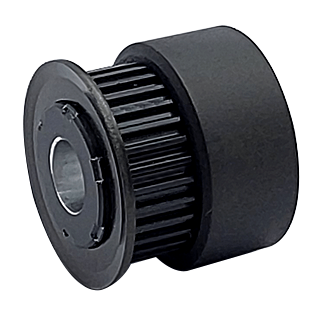- Home
- Products
- Transmission Parts
- Timing Pulley
- Timing Pulley-S2M
Number of gears14~72˙High torque transmission˙Aluminum Material/S45C˙five Surface Treatment Options
- Product Specification
- Product Characteristics
- Why you must choose HEADWAY
| S2M | A | AL | WA | 4 | 14 | H3 | KC90 |
|---|---|---|---|---|---|---|---|
| | | | | | | | | | | | | | | | |
| Teeth type | Shape | Material | Surface Treatment | Belt Width | Number of teeth | Processing project of shaft hole | Processing Projects |

| Material | Aluminum AL | Medium Carbon Steel CS | |||||
|---|---|---|---|---|---|---|---|
| Surface Treatment | White anode WA |
Hard anode HA |
Black anode BA |
Electroless nickel NE |
- | Black oxide BK |
Electroless nickel NE |
| *Hard anode to a film's hardness of 300HV~. *A small part of the processed area may not have a surface treatment. |
|||||||
| Shaft hole processing items (refer to P . 0.7 - 0.8 for keyway and grommet groove dimensions). | |||||||
|---|---|---|---|---|---|---|---|
| H Round hole |
P Round hole + tapping |
N(new JIS) C(old JIS) Keyway holes + tapping |
V Neck hole |
WB Double neck holes |
Y Both ends neck holes |
F Neck hole (Hub Side Countersunk Hole) |
|
| Shape A | Shape B | Shape A | Shape A | Shape B | |||
 |
 |
 |
 |
 |
 |
 |
 |
| Accessory fixing screws for P, N, C-axis hole processing service. | ||
|---|---|---|
| Axis diameter | 2-M thick thread | Attachment Fixing Screws |
| 3~5 | M3 | M3X3 |
| 6~24 | M4 | M4X3 |
| 25~30 | M5 | M5X4 |
| *Flanged riveted, shaft holes P, N, C with fixing screws | ||
- Tolerance of hole dimensions on the hub side and end faces is ±0.3.
- No tapped holes and set screws for H, V, Y, WB, F shaft holes.
- For H, P, V, the shaft hole diameter can be selected from 4.5, 6.35 as long as it is within the selection range.
- When the shaft hole specification is N, it is not possible to make the shaft hole diameter of 9
- NK10 can also be selected within the range of options when the shaft hole specification is N.
- When the shaft hole specification is C, it is not possible to make shaft hole diameter of 8, 9, 11, 13, 14, 17, 21-26.
- Z-V ≥ 2 when the shaft hole specification is V.
- Q(R) - Y≥2 for Y shaft hole specification ; applicable to A-shape only.
- Q-R ≥ 2 and R-WB ≥ 2 for WB shaft hole specification; for A-shape only.
- Z-F≥2 for F shaft hole specification; for B-shape only.
Materials and Characteristics of Commonly Used Belts and Pulleys
Common Belt Materials
Belts are typically made of rubber polymers, which may be reinforced with synthetic or organic fibers to enhance strength, or may contain other fillers to improve performance based on individual applications.
Common Pulley Materials and Their Characteristics
There is a wide range of material choices available today. Here are three commonly used pulley materials:
1. Aluminum
Aluminum is one of the most commonly used materials in timing belt pulley designs, primarily due to its durability and lightweight nature. This material also possesses good tensile strength, making it suitable for applications requiring high load-carrying capacity pulleys.
Aluminum is also corrosion-resistant; when exposed to moisture (or oxygen), it forms a thin oxide layer, preventing further oxidation and thus corrosion. This makes aluminum the ideal material for timing belt pulleys in environments prone to moisture.
2. Steel
Steel typically offers excellent strength and durability at a more affordable price compared to other materials (including aluminum). However, it's important to note that steel is heavier than aluminum (with a density approximately 2.5 times greater). Steel is also harder than aluminum and may not be pushed to the same extreme dimensional limits without cracking or deformation.
3. Plastic
Plastics combine the lightweight and corrosion-resistant advantages of aluminum with the cost-effectiveness of steel, making them well-suited for applications exposed to corrosive environments or conditions involving fluids, flammable gases, and solvents.
*Please choose HEADWAY timing belt pulleys based on your working environment and usage conditions.
| Material | Power Transmission | Strength | Weight | Durability | Chemical Resistance | Corrosion Resistance | Suggested Enhancement |
|---|---|---|---|---|---|---|---|
| Aluminum | Medium | Medium | Light | Moderate | Moderate | Moderate | Use stainless steel flanges for suggestion |
| Stainless Steel | High | High | Heavy | High | Excellent | Excellent | - |
| Steel | High | High | Heavy | High | Low | Low | - |
| Plastic | Low | Low | Light | Moderate | Excellent | Excellent | - |
| Surface Treatment | Durability | Corrosion Resistance | Surface Hardness | Wear Resistance | Chemical Resistance |
|---|---|---|---|---|---|
| Anodizing | ● | ● | ● | ||
| Hard Anodizing | ● | ● | ● | ● | |
| Blackening | ● | ● | |||
| Chromium Plating | ● | ● | ● | ● | |
| Electroless Nickel Plating | ● | ● |
These treatments can significantly improve the performance and longevity of these materials in various applications.
Timing Belt Pulley and Belt Terminology and Parameters
Figure 2-1.1 shows a typical timing belt pulley and its related important parameters, which will be used to explain the following terms.
(1) Pitch
Pitch refers to the distance from the center of one tooth to the center of an adjacent tooth. It is measured on the pitch circle (or sprocket pitch circle). When specifying a belt and timing belt pulley drive system, it should be set to the same pitch to ensure proper engagement between the belt and the timing belt pulley.
(2) Pitch Circle
An imaginary circle formed by the centers of the teeth.

(3) Outside Diameter
The outermost surface of a timing pulley that directly contacts the bottom surface of the belt when they mesh. The diameter formed by this outermost surface is called the outside diameter and can be calculated using the following formula:
Outside Diameter = Pitch Diameter - (2 * U)
(4) Pitch Diameter
The pitch diameter is the diameter of the pitch circle.
(5) Pitch Point : The point where the pitch circles of two meshing gears are tangent.
U = (outside diameter - pitch diameter) distance from sprocket pitch circle to the outer surface of the timing belt pulley.
(6) Speed Ratio
As the name implies, the speed ratio is the ratio of the speed of the driven pulley (measured in revolutions per minute) to the speed of the driving pulley. It can also be calculated by dividing the number of teeth on the large pulley by the number of teeth on the small pulley, as shown in the diagram. To summarize the tooth profiles available for selection:
To summarize the tooth profiles available for selection:
| Regular torque | |||
|---|---|---|---|
| MXL | XL | L | H |
 |
 |
 |
 |
| High Torque | ||||
|---|---|---|---|---|
| S2M | S3M | S5M | S8M | S14M |
 |
 |
 |
 |
 |
| P2M | P3M | P5M | P8M |
|---|---|---|---|
 |
 |
 |
 |
| High Accuracy Positioning | |||
|---|---|---|---|
| 2GT | 3GT | 5GT | 8YU |
 |
 |
 |
 |
| Light Load Conveyance, Regular Torque | Heavy Load Conveyance | ||
|---|---|---|---|
| T5 | T10 | AT5 | AT10 |
 |
 |
 |
 |
*These profiles offer a range of options suitable for various applications.
HEADWAY presents you with superior quality, firm commitment, and a spirit of partnership. As a manufacturer of automation and mold components, we possess deep knowledge of automation and mold technology, continuously innovating and improving to ensure outstanding performance and reliability.
On the official HEADWAY website, you can not only browse product catalogs but also understand that each product represents our commitment to quality and our responsiveness to customer needs. We rigorously control the manufacturing process, utilizing high-quality materials and precision machining to ensure that every product meets your expectations.
(1).Streamlined Production
(2).No minimum order quantity, we can produce even one.
(3).100% inspection - From production to inspection equipment, all steps are completed by HEADWAY.
(4).Accept custom processing inquiries based on provided drawings.
(5).For product issues and subsequent after-sales service, we provide personalized assistance for you.











